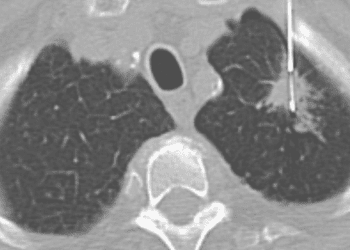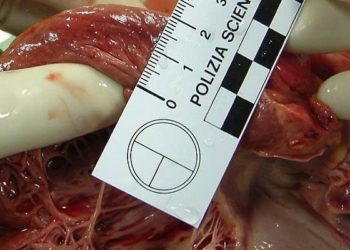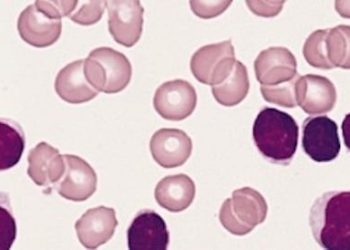Nivolumab+AVD improves progression-free survival in advanced-stage Hodgkin lymphoma
1. This randomized controlled trial found that in patients with newly diagnosed stage III or IV Hodgkin lymphoma, treatment with nivolumab + AVD (N+AVD) led to longer progression-free survival compared to brentuximab vedotin + AVD (BV+AVD).
2. N+AVD treatment resulted in fewer high-grade adverse events compared to BV+AVD, except neutropenia.
Evidence Rating Level: 1 (Excellent)
Study Rundown: The combination chemotherapy of doxorubicin, bleomycin, vinblastine, and dacarbazine (ABVD) has long been the standard for advanced-stage Hodgkin lymphoma. However, efforts continue to improve efficacy and reduce the toxicity associated with this regimen. The introduction of brentuximab vedotin, a CD30-directed antibody-drug conjugate, led to the development of a new treatment regimen: BV+AVD. Despite its effectiveness, challenges such as relapse rates and elevated toxicity have arisen. An alternative approach involves replacing brentuximab vedotin with nivolumab (N+AVD), a programmed death receptor-1 (PD-1) inhibitor already used for relapsed Hodgkin lymphoma. This study compared the efficacy and safety of BV+AVD and N+AVD in adolescent and adult patients newly diagnosed with stage III or IV classic Hodgkin lymphoma. Results demonstrated that patients receiving N+AVD had significantly better progression-free survival compared to those treated with BV+AVD. Additionally, a higher percentage of patients in the N+AVD group achieved two-year event-free survival compared to the BV+AVD group. However, overall survival did not differ significantly between the two treatments. Patients treated with BV+AVD had higher rates of severe adverse events overall, except for neutropenia, which was more frequent in the N+AVD group. The study had several limitations, including a short follow-up period, insufficient power for secondary and subgroup analyses, and a population predominantly reflective of a European demographic. Despite these limitations, the findings suggest that N+AVD is effective and has a more favorable side effect profile, making it a potential primary treatment option for patients with advanced-stage Hodgkin lymphoma.
Click here to read the study in NEJM
In-Depth [randomized controlled trial]: This phase three randomized controlled trial evaluated the efficacy and safety of N+AVD and BV+AVD chemotherapy regimens in the treatment of stage III and IV Hodgkin lymphoma. Patients were eligible if they were over 12 years old, had untreated stage III or IV Hodgkin lymphoma, and had a Zubrod performance score of 0 to 2 (on a 5-point scale with higher scores indicating greater disability) or, if younger than 17, a Lansky performance score of 50 to 100 (on a 100-point scale where higher scores indicate better functioning). Exclusion criteria included active autoimmune disease, pre-existing interstitial lung disease, or peripheral neuropathy greater than grade two. Following randomization, 496 patients received N+AVD, and 498 received BV+AVD. The primary outcome was progression-free survival, defined as the time from randomization to signs of disease progression. At the second planned interim analysis, N+AVD was deemed to have significantly improved progression-free survival in comparison to the BV+AVD treatment (hazard ratio for disease progression or death, 0.48; 99% confidence interval [CI], 0.27 to 0.87; two-sided p=0.001). At the two-year mark, the progression-free survival for N+AVD-treated patients was 92% (95% CI, 89–94), compared to 83% for BV+AVD-treated patients (95% CI, 79–86) (hazard ratio for disease progression or death, 0.45; 95% CI, 0.30-0.65). Secondary outcomes included overall survival, event-free survival, and the incidence of adverse events. At two years, 99% of patients in the N+AVD group and 98% in the BV+AVD group had survived (hazard ratio for death, 0.39; 95% CI, 0.15–1.03). Additionally, 90% of N+AVD-treated patients had event-free survival at two years, compared to 81% in the BV+AVD group (stratified hazard ratio for death, 0.50; 95% CI, 0.36–0.71). Patients treated with BV+AVD experienced more frequent high-grade adverse events, except for neutropenia. Specifically, 22% more patients in the N+AVD group experienced grade 3 or higher neutropenia. Nevertheless, no significant differences were found between the groups in terms of febrile neutropenia, sepsis, or infections. Overall, the longer progression-free survival and better safety profile suggest that N+AVD may be an effective treatment option for advanced-stage Hodgkin lymphoma.
Image: PD
©2024 2 Minute Medicine, Inc. All rights reserved. No works may be reproduced without expressed written consent from 2 Minute Medicine, Inc. Inquire about licensing here. No article should be construed as medical advice and is not intended as such by the authors or by 2 Minute Medicine, Inc.







